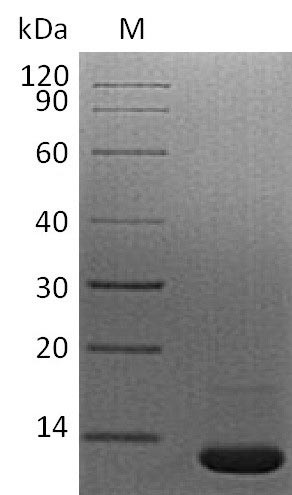Recombinant Mouse Transforming Growth Factor Beta-1 Proprotein (Tgfb1) is produced through a mammalian cell expression system, which appears to provide high authenticity and activity levels. The protein remains tag-free, preserving its natural form. It comes in a partial length spanning 279-390 amino acids and shows purity greater than 95% based on SDS-PAGE analysis. Endotoxin levels are carefully maintained below 1.0 EU/µg, which likely ensures safety during experimental work. Biological activity has been confirmed with an ED50 of 5-25 pg/ml when inhibiting IL-4-dependent proliferation of TF-1 human erythroleukemic cells.
Transforming Growth Factor Beta-1 (Tgfb1) stands as an important cytokine that participates in numerous cellular processes. These include cell growth, differentiation, and immune modulation. The protein seems to play a substantial role in immune system regulation and tissue homeostasis maintenance. TGF-beta1 research spans areas like cancer, fibrosis, and wound healing studies, where it serves as a key element for understanding signal transduction pathways and how cells respond to various stimuli.
Potential Applications
Note: The applications listed below are based on what we know about this protein's biological functions, published research, and experience from experts in the field. However, we haven't fully tested all of these applications ourselves yet. We'd recommend running some preliminary tests first to make sure they work for your specific research goals.
1. Cell Proliferation Inhibition Assays
The confirmed biological activity (ED50 of 5-25 pg/ml in inhibiting IL-4-dependent proliferation of TF-1 cells) directly validates its use in cell proliferation inhibition studies. The high purity (>95%) and low endotoxin levels (<1.0 EU/μg) make it suitable for sensitive cell culture experiments. Researchers can reliably use this protein to study Tgfb1-mediated growth inhibition across different cell models.
2. Tgfb1 Signaling Pathway Studies
This application is appropriate. The mammalian expression system ensures proper folding and post-translational modifications necessary for receptor binding and signal transduction. The confirmed bioactivity supports its use in activating downstream Smad signaling pathways. However, the description should note that while the protein is active, the partial sequence (279-390aa) represents the mature Tgfb1 region but may not include all prodomain interactions that could influence signaling kinetics in some contexts.
3. Antibody Development and Validation
This application is well-supported. The high purity, mammalian cell expression (ensuring native conformation), and confirmed bioactivity make this an excellent immunogen for generating specific antibodies. The tag-free nature avoids immune responses to non-native epitopes. The bioactivity enables functional validation of neutralizing antibodies using the TF-1 cell proliferation assay described in the activity data.
4. Protein-Protein Interaction Studies
This application is feasible but requires qualification. While the mammalian expression system and confirmed activity suggest proper folding for receptor binding, the partial sequence (279-390aa) may not include all interaction domains present in the full-length proprotein. The high purity supports biophysical binding studies (SPR/BLI), but researchers should verify that the specific interactions being studied (e.g., with latency-associated peptide or other regulators) are mediated by the expressed region.
Final Recommendation & Action Plan
This recombinant mouse Tgfb1 proprotein fragment is highly suitable for all described applications due to its confirmed biological activity, high purity, mammalian cell expression, and low endotoxin levels. The ED50 value (5-25 pg/ml) demonstrates potent bioactivity, validating its use in functional assays. Researchers can proceed confidently with cell-based studies and antibody development. For interaction studies, ensure the binding partners interact with the mature Tgfb1 region (279-390aa) contained in this construct. The mammalian expression system provides appropriate folding and modifications, making this reagent reliable for Tgfb1 signaling research. Always include appropriate controls (e.g., Tgfb1 inhibitors) to confirm specificity in experimental systems.






